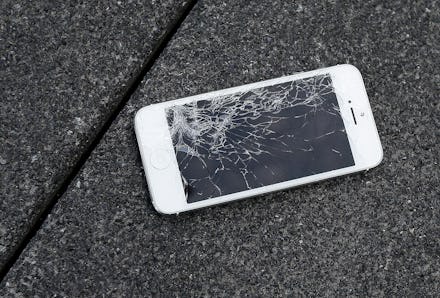It's Expensive to Get Your iPhone or iPad Fixed — And Apple Wants It That Way

If you drop your iPhone into a body of water, it's probably toast. And if it's not bricked, it could cost you from $269 to $329 in repairs because liquid damage is not covered in an Apple warranty. Good thing you can go to a third-party repair shop that can repair your device for cheaper, right?
Apple just helped to squash those dreams.
New York legislators introduced the Fair Repair Act, which would require manufacturers like Apple to provide information and parts needed to repair a device. Apple, IBM, Xerox and Cisco all lobbied against it, and the legislation failed to get a vote, the Huffington Post reported.
While taking the iPhone to a third-party repair shop isn't illegal, these shops don't have access to repair instructions or the necessary parts to most efficiently fix your device.
Apple's take: Apple might not want such a bill to pass because of the risk of someone reverse-engineering an iDevice and creating counterfeit ones, the Huffington Post reported, or because these outside repair shops might damage the "integrity" of a phone.
The Repair Association, a group that campaigned for the pass of the Fair Repair Act, writes on its website that worrying about damage to "brand image," or concerns that a third-party repair shop might not properly fix an iDevice, is irrelevant.
"Owners of equipment have no obligation to the manufacturer post purchase related to supporting brand image," the group writes. "It is also disingenuous to withhold the means to make competent repairs and then demand a monopoly on the basis of competence."
Nearly 15,000 letters were sent to New York's senators and representatives via the Repair Association's website in support of the bill.
Environmental impact: Making Apple's (and other device manufacturers) repair instructions and parts publicly accessible isn't just economically beneficial to iPhone consumers with a habit of dropping their device in the toilet, it's environmentally beneficial.
A study from September 2014 found that of the 1.8 billion new mobile phones "likely" purchased that year, 44% end up in a drawer, 4% end up in landfills and 3% are recycled.
The average age for a kid to get their first smartphone is 10.3 years old, and the average American gets a new one every 1.5 to 2.5 years. That's more than five phones that could end up in a drawer or landfill before you're old enough to buy a beer.
The Fair Repair Act could have extended the life expectancy of one phone by expanding the pool of professional repairers. And someone doesn't even have to keep their phone forever — it could be fixed for another consumer, encouraging the purchase of a used working phone rather than the current cycle of planned obsolescence.
"The manufacturing impact of the electronic sector is huge," Kyle Wiens, a repair advocate and founder of iFixit, a free repair manual on just about anything, told the Washington Post. "If you're going to go to all the effort and environmental impact to make a phone, let's make it last for seven or 10 years. And it's OK if it's not necessarily used by the first owner for all that long, but let's make it so that somebody can use it."
Apple has made an effort to wrangle back some of its now unused devices; the company has a robot named Liam, and its purpose is to disassemble iPhones and sorts parts to be recycled. But as cute as Liam might be, it still isn't a surefire way to recycle all of the unused iPhones out there. In fact, at this point it can only take apart the iPhone 6s.
According to Reuters, with Liam's rate of taking apart an iPhone in 11 seconds, even if uninterrupted, it "likely can handle no more than a few million phones per year, a small fraction of the more than 231 million phones Apple sold in 2015."
Mic reached out to Apple for comment and will update with a response.
Read more: